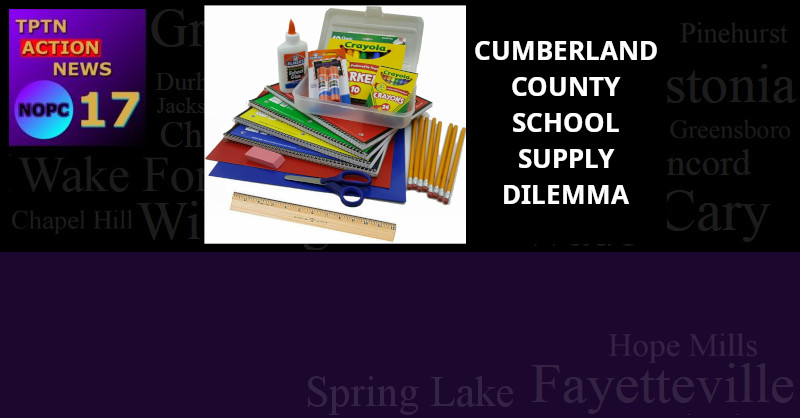
Who Pays for Pencils? Teachers Say North Carolina’s School Supply Funds Fall Short
Parents Provide, Teachers Still Pay
Every August, parents in Cumberland County make the rounds at big-box stores, filling carts with binders, pencils, notebooks, and glue sticks from supply lists published by their children’s schools. The expectation seems clear, families provide the basics.
Yet teachers in the county still report spending hundreds of dollars of their own money to keep classrooms running.
“I bought earbuds and notebooks last month because I had students who simply had nothing,” one middle school teacher said. “If I don’t cover it, the kids go without.”
What PRC 061 Is Supposed to Do
The state of North Carolina directs money for classroom materials through a budget line called PRC 061. According to the Department of Public Instruction, PRC 061 is meant to fund:
Instructional supplies and materials
Small instructional equipment
Testing support, including PSAT and PreACT costs required by G.S. 115C-174.18
For the 2023–24 school year, the formula was $38.07 per student, plus $2.69 per student in grades 8 and 9 to cover PSAT costs. Statewide, that equaled about $53.6 million.
Cumberland County Schools, with roughly 48,000 to 49,000 students, received an estimated $1.86 to $1.89 million in PRC 061 funds.
Where the Money Goes
PRC 061 doesn’t flow straight into pencil boxes. Principals, not the state, decide how to spend their share. Many allocate funds to building-wide needs like copier paper, toner, laminating film, chart paper, and dry erase markers. Others must reserve funds for science lab supplies, art materials, or small classroom equipment such as calculators and headphones.
That leaves less for individual student kits. Schools such as Pine Forest Middle still publish lengthy supply lists asking parents to provide:
Two-inch binders and dividers
Loose-leaf and graph paper
Number two pencils and eraser caps
Composition notebooks
Colored pencils and highlighters
Glue sticks, earbuds, and AAA batteries
Tissues, sanitizer, wipes, and printer paper
“We’re essentially double-paying,” said a parent of two Pine Forest students. “We buy the supplies, the state says it funds supplies, and teachers still cover gaps.”
Sidebar: What Is PRC 061?
Code Name: Program Report Code 061
Purpose: Classroom materials, supplies, small equipment, testing support
Eligibility: Every school district (LEA) gets funds
Special Rule: Testing costs like the PSAT must be paid from PRC 061
Transfers: Districts may move PRC 061 dollars to other categories with an ABC Transfer Form
Teachers Shouldn’t Have to Pay
National surveys show American teachers spent an average of $895 of their own money in 2024–25, while schools budgeted only about $200 per teacher for supplies. In Cumberland County, anecdotes echo that reality.
Critics say relying on teacher generosity flirts with ethical problems. The Code of Ethics for Educators and Standards for School Executives emphasize stewardship of public resources. Yet some administrators are seen as “counting on” staff to cover predictable deficits.
“It creates the perception of unethical coercion,” said one retired principal. “Teachers feel pressured to step in because leadership hasn’t made supplies a priority.”
Sidebar: What the Law Says
G.S. 115C-174.18: Requires one PSAT or PreACT opportunity at no cost to students in grades 8–10 after Algebra I. Paid with PRC 061.
G.S. 115C-47: Local school boards must approve and publish any fees. Families cannot be charged unofficially.
A Bill to Guarantee Supplies
A proposed measure, tentatively titled the “Classroom Supplies Guarantee Act,” would require PRC 061 funds to cover a full supply kit for every student before any other spending. Items include binders, dividers, pencils, pens, crayons, notebooks, glue sticks, earbuds, batteries, tissues, sanitizer, wipes, and printer paper.
The draft also bans teachers from using personal funds, declaring that administrators may not “directly or indirectly request, encourage, or rely upon such expenditures.”
Supporters argue the law would eliminate confusion and restore trust. Critics point to cost, estimating $35 per student would consume almost all of PRC 061’s $48 million pool, leaving little for shared supplies or testing.
Sidebar: Fiscal Snapshot
PRC 061 per student 2023–24: $38.07 + $2.69 (grades 8–9)
Statewide funding: ≈ $53.6 million
Cumberland County share: ≈ $1.86–1.89 million
Estimated kit cost per student: $22–$50
Total statewide cost for kits: $33.8–$76.9 million
Transparency Still Missing
Parents who want to know how much PRC 061 their school actually received can’t find it online. The state posts district totals, but not school-by-school breakdowns. To learn how funds were divided within Cumberland County, citizens must file a public records request with the Finance Department asking for a ledger by school, vendor, and object code.
The Question Ahead
Parents are paying. Teachers are paying. The state is paying. Yet classrooms still lack basic supplies.
Whether the General Assembly acts on the proposed bill or Cumberland County publishes more transparent budgets, the fundamental issue remains, who should bear the cost of equipping every child for learning?
